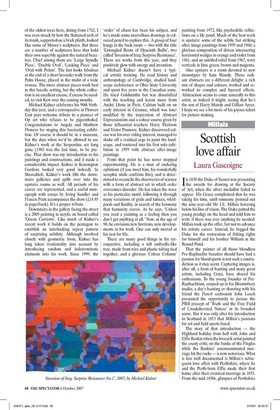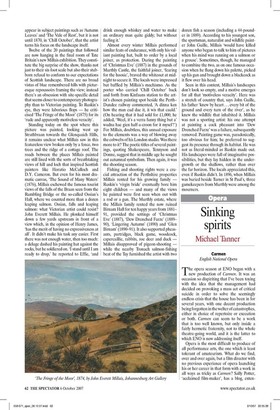Scottish love affair
Laura Gascoigne In 1838 the Duke of Sussex was presenting the awards for drawing at the Society of Art, when the silver medallist failed to appear. His Grace complained that he was taking his time, until someone pointed out the nine-year-old Mr J.E. Millais hovering below his line of vision. The Duke patted the young prodigy on the head and told him to write if there was ever anything he needed. Millais took up the offer, but not to advance his artistic career. Instead, he begged the Duke for the restoration of fishing rights for himself and his brother William in the Round Pond.
That the painter of all those bloodless Pre-Raphaelite beauties should have had a passion for blood sports is not such a contradiction as it may seem. Capturing images is, after all, a form of hunting and many great artists, including Goya, have shared his enthusiasm. To the young founder of PreRaphaelitism, cooped up in his Bloomsbury studio, a day's hunting or shooting with his friend the Punch cartoonist John Leech presented the opportunity to pursue the PRB precept of 'Truth and the Free Field of Unadulterated Nature' in its broadest sense. But it was only after his introduction to Scotland in 1853 that Millais's passions for art and field sports fused.
The story of that introduction — the Highland holiday from hell with John and Effie Ruskin when the lovesick artist painted the crusty critic on the banks of the Finglas while the Ruskins' unconsummated marriage hit the rocks — is now notorious. What is less well documented is Millais's subsequent love affair with Perthshire, where he and the Perth-born Effie made their first home after their eventual marriage in 1855. From the mid-1850s, glimpses of Perthshire appear in subject paintings such as 'Autumn Leaves' and 'The Vale of Rest', but it is not until 1870, in 'Chill October', that the artist turns his focus on the landscape itself.
Twelve of the 20 paintings that followed are now hanging in the final room of Tate Britain's new Millais exhibition. They constitute the big surprise of the show, thanks not just to their six-foot scale but also their stubborn refusal to conform to our expectations of Scottish landscape. There are no broad vistas of blue remembered hills with picturesque repoussoirs framing the view; instead there's an obsession with site-specific detail that seems closer to contemporary photography than to Victorian painting. To Ruskin's eye, they were laborious flops — he criticised 'The Fringe of the Moor' (1875) for its 'rude and apparently motiveless veracity'.
Standing today on the spot where this picture was painted, looking west up Strathbraan towards the Glenquaich Hills, it remains unclear what Millais saw in this featureless view broken only by a fence, two trees and the ridge of a cottage roof. The roads between the places Millais painted are still lined with the sorts of breathtaking views of hill and loch that inspired Scottish painters like Horatio McCulloch and D.Y. Cameron. But even for his most dramatic canvas, 'The Sound of Many Waters' (1876), Millais eschewed the famous tourist views of the falls of the Braan seen from the Rumbling Bridge or the so-called Ossian's Hall, where we counted more than a dozen leaping salmon. Ossian, falls and leaping salmon: what Victorian artist could resist? John Everett Millais. He plonked himself down a few yards upstream in front of a view which, in the opinion of Henry James, 'has the merit of having no expressiveness at all'. It didn't make his task any easier. First there was not enough water, then too much: a deluge dashed his painting hut against the rocks, but he soldiered on. 'I stand until I am ready to drop,' he reported to Effie, 'and drink enough whiskey and water to make an ordinary man quite giddy; but without feeling it.'
Almost every winter Millais performed similar feats of endurance, with only his valiant painting hut, built to order by a local joiner, as protection. During the painting of 'Christmas Eve' (1887) in the grounds of Murthly Castle, the faithful joiner, 'fearing for the hoosie', braved the whiteout at midnight to secure it. The locals were impressed but baffled by Millais's machismo. As the porter who carried 'Chill October' back and forth from Kinfauns station to the artist's chosen painting spot beside the Perth– Dundee railway commented, 'A dinna ken how the man cud dae it, it wis that cauld.' (On hearing that it had sold for £1,000, he added, 'Wed, it's a verra funny thing but a' wudna hae gien half-a-croon for it mysel'!') For Millais, doubtless, this annual exposure to the elements was a way of blowing away the cobwebs of his London studio. Was there more to it? The poetic titles of several paintings, quoting Shakespeare, Tennyson and Donne, suggest that in middle age he sought out autumnal symbolism. Then again, it was the shooting season.
Fishing and shooting rights were a crucial attraction of the Perthshire properties Millais rented for his growing family — Ruskin's 'virgin bride' eventually bore him eight children — and many of the views he painted were first seen when out with a rod or a gun. The Murthly estate, where the Millais family rented the now ruined Birnam Hall for ten happy years from 1881– 91, provided the settings of 'Christmas Eve' (1887), 'Dew Drenched Furze' (188990), 'Lingering Autumn' (1890) and 'Glen Birnam' (1890-91). It also supported pheasants, partridges, black game, woodcock, capercaillie, rabbits, roe deer and duck — Millais disapproved of pigeon-shooting — while the nearby Tronach salmon-fishing beat of the Tay furnished the artist with two dozen fish a season (including a 44-pounder in 1889). According to his youngest son, the sportsman, naturalist and wildlife painter John Guille, Millais 'would have killed anyone who began to talk to him of pictures when his mind was running on a salmon or a grouse'. Sometimes, though, he managed to combine the two, as on one famous occasion when he flung down his palette, picked up his gun and brought down a blackcock as it flew over his head.
Seen in this context, Millais's landscapes don't look so empty, and a motive emerges for all that 'motiveless veracity'. Here was a stretch of country that, says John Guille, his father 'knew by heart ... every bit of the ground and every turn of the river', as he knew the wildlife that inhabited it. Millais was not a sporting artist: his one attempt at painting a cock pheasant into 'Dew Drenched Furze' was a failure, subsequently removed. Painting game was, paradoxically, too obvious for him; he preferred to suggest its presence through its habitat. He was not as literal-minded as Ruskin made out. His landscapes were full of imaginative possibilities, but they lay hidden in the undergrowth or the shallows, rather than over the far horizon. The locals appreciated this, even if Ruskin didn't. In 1896, when Millais was buried beside Turner in St Paul's, three gamekeepers from Murthly were among the mourners.






























































 Previous page
Previous page